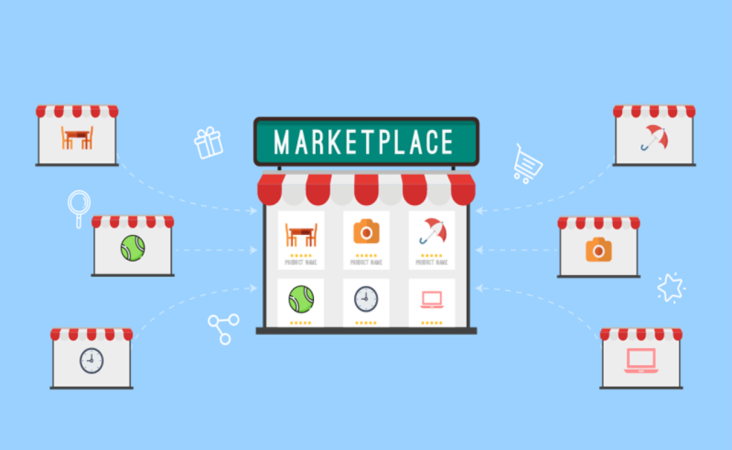
How To Build A Multi-Vendor Ecommerce Marketplace?
18 May 24
How To Build A Multi-Vendor Ecommerce Marketplace?
Building a multi-vendor e-commerce marketplace can be a lucrative venture, but it requires careful planning and execution. In this comprehensive guide, we'll walk you through the steps to create your own successful multi-vendor platform. Introduction - What is a multi-vendor e-commerce marketplace? - Importance and benefits Understanding the Concept - Definition and Functionality - Comparison with traditional e-commerce platforms Planning Your Multi-Vendor Marketplace - Market research and niche selection - Business model and revenue streams Choosing the Right Platform - Factors to consider - Popular multi-vendor platforms comparison Setting Up Your Marketplace - Domain registration and hosting - Customization options and design Vendor Management System - Onboarding vendors - Vendor dashboard and management tools Payment Gateway Integration - Secure payment processing - Choosing the right payment gateway provider Building Trust and Credibility - Vendor verification and rating system - Customer reviews and feedback mechanisms Marketing Your Marketplace - SEO optimization and content strategy - Social media marketing and influencer partnerships Managing Operations and Logistics - Order fulfillment and shipping - Inventory management and tracking Providing Customer Support - Helpdesk and support channels - Handling disputes and refunds Scaling Your Marketplace - Growth strategies and expansion plans - Adding new features and functionalities Conclusion - Recap of key points - Final thoughts on building a successful multi-vendor e-commerce marketplace Introduction In today's digital age, e-commerce marketplaces have revolutionized the way we shop. A multi-vendor e-commerce marketplace takes this concept a step further by allowing multiple vendors to sell their products on a single platform. This creates a win-win situation where vendors can reach a wider audience, and customers have access to a diverse range of products. Understanding the Concept A multi-vendor e-commerce marketplace is essentially an online platform where multiple vendors can sign up and sell their products. Unlike traditional ecommerce platforms where a single entity sells its own products, a multi-vendor marketplace acts as a facilitator, connecting buyers and sellers. This model allows for a wider variety of products and a more competitive pricing environment. Planning Your Multi-Vendor Marketplace Before diving into the development process, it's essential to have a clear plan in place. Start by conducting thorough market research to identify potential niches and target audiences. Determine your business model, whether it's a commission-based model, subscription model, or a combination of both. Outline your revenue streams, such as transaction fees, subscription fees, or advertising revenue. Choosing the Right Platform Selecting the right platform is crucial for the success of your multi-vendor marketplace. Consider factors such as scalability, customization options, ease of use, and integration capabilities. Popular platforms like Shopify, WooCommerce, and Magento offer robust multi-vendor solutions with a wide range of features and functionalities. Setting Up Your Marketplace Once you've chosen a platform, it's time to set up your marketplace. Start by registering a domain name and choosing a reliable hosting provider. Customize your marketplace to align with your branding and design preferences. Consider hiring a developer or using pre-made themes and templates to expedite the setup process. Vendor Management System A robust vendor management system is essential for managing multiple vendors effectively. Implement features like vendor onboarding, product listing management, order processing, and payout management. Provide vendors with their own dashboard where they can track sales, manage inventory, and communicate with customers. Payment Gateway Integration Integrating a secure payment gateway is crucial for facilitating transactions on your marketplace. Choose a payment gateway provider that offers seamless integration, robust security features, and support for multiple payment methods. Ensure compliance with PCI-DSS standards to safeguard sensitive customer information. Building Trust and Credibility Building trust and credibility is key to attracting customers and vendors to your marketplace. Implement a vendor verification process to ensure the legitimacy of sellers. Incorporate a rating and review system where customers can provide feedback on their shopping experience. Encourage vendors to provide high-quality products and excellent customer service to maintain positive ratings. Marketing Your Marketplace Once your marketplace is up and running, it's time to focus on marketing and promotion. Develop an SEO strategy to improve your search engine rankings and drive organic traffic to your site. Utilize social media platforms, email marketing, and influencer partnerships to reach your target audience. Offer promotions, discounts, and loyalty programs to incentivize customers to shop on your marketplace. Managing Operations and Logistics Managing operations and logistics is crucial for ensuring a seamless shopping experience for your customers. Implement an efficient order fulfillment process to minimize shipping times and costs. Integrate with shipping carriers to provide accurate tracking information to customers. Implement inventory management tools to keep track of stock levels and prevent overselling. Providing Customer Support Providing exceptional customer support is essential for building long-term relationships with your customers. Offer multiple support channels such as live chat, email, and phone support. Implement a helpdesk system to track and resolve customer inquiries in a timely manner. Handle disputes and refunds professionally to maintain customer satisfaction. Scaling Your Marketplace As your marketplace grows, it's important to scale your operations accordingly. Implement growth strategies such as expanding into new markets, adding new product categories, or partnering with complementary businesses. Continuously monitor your marketplace performance and gather feedback from customers and vendors to identify areas for improvement. Conclusion In conclusion, building a multi-vendor e-commerce marketplace is a complex but rewarding endeavor. By following the steps outlined in this guide, you can create a successful platform that connects buyers and sellers and drives revenue for your business.


CALL
Ready to Work Together In New Projects ?
Services
App Development
Web App Development
Digital Marketing
UI And UX Designing
Custom Mobile And Web Development
Free Tools
Quick Links
Our Apps
Find us on Clutch
Privacy & Policy
Shipping & Delivery Policy
Return & Refund Policy
Terms & Condition
FAQs
Legal
Contact
Hyde Park Crown First Floor, FF-14-21 Plot No GH-03 Sector-78, Noida, Uttar Pradesh 201306
info@2digitinnovations.com
+91 7814042409
